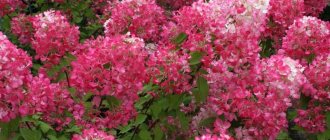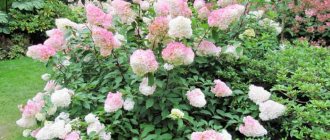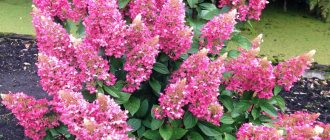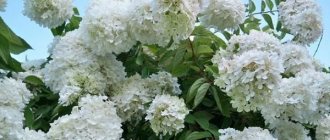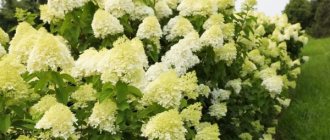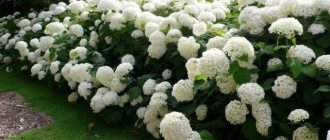Paniculate hydrangea Diamond Rouge (Diamant Rouge ® Rendia) is a relatively new modern variety. The name translates as “Red Diamond” and may go on sale as Rendia. The cultivar was presented to the public at the Dutch flower exhibition Plantarium (Boskop) in 2011, where it received a silver medal. The authorship belongs to the French breeder Jean Reno, owner of the Pepinieres Renault nursery.
Characteristics of the variety on the Pepiniers Renault website: “Hydrangea paniculata Diamant Rouge is the reddest of our diamonds.”
Description of hydrangea paniculata Diamond Rouge and characteristics
Hydrangea Diamond Rouge has strong shoots of a reddish-brown color, directed vertically upward. The bushes are spreading and can reach 1.2 m in diameter. Hydrangea leaves are elliptical or ovoid, with a pointed tip and small teeth along the edges, with clearly visible veins. On the shoots they are located opposite, covered with small villi. In the spring-summer period, the plates remain dark green in color, and in the fall they become orange or yellow with blurry red spots.
Attention! Hydrangea has a superficial branched root system that extends beyond the crown. When planting several bushes, you need to leave space between them.
The Diamond Rouge variety grows at an average speed. Hydrangea is not prone to aggressively taking over a site, so it can be placed next to other shrubs and herbaceous perennials. You just need to make sure that the plants do not take away moisture and nutrients from each other. The variety is resistant to unfavorable ecology and is well suited for cultivation in areas with polluted air.
Blooming Hydrangea Diamond Rouge
Hydrangea Diamond Rouge blooms on average from the first days of July; in the south it can bear flowers as early as the end of June. Produces large panicles 30-40 cm long in the shape of a cone with a wide base and a rounded top. In this case, the inflorescences do not seem massive, but retain an openwork structure, since large and small buds are distributed approximately equally in them.
The flowering of Diamond Rouge hydrangea largely depends on the conditions. With short pruning, the crop produces the largest and most lush panicles. With irregular watering and excess sun, as well as on unsuitable soil, the inflorescences will be smaller, only about 20 cm in length.
Diamond Rouge blooms for quite a long time and can remain attractive until October
The color of hydrangea changes several times during the season. At the very beginning of the decorative period, the inflorescences are white, after 2-3 weeks they begin to turn pink and, ultimately, acquire a deep crimson hue. For the rest of the time, the buds retain their rich color and shortly before drying out they become dark ruby.
Attention! For the first time, Diamond Rouge hydrangea blooms only in the third year of life. The formation of buds occurs on the shoots of the current season.
When growing hydrangea in a summer cottage, it is necessary to provide it with comfortable conditions and an annual haircut. Otherwise, Diamond Rouge will develop more slowly, and the inflorescences will become less spectacular, since they will remain modest in size and will no longer be able to dot the entire bush with huge lush caps.
Frost resistance of hydrangea paniculata variety Diamond Rouge
The winter hardiness of Diamond Rouge hydrangea is quite high. Even with minimal shelter, the variety can tolerate cold temperatures down to -30 °C.
The shrub is best suited for growing in the Moscow region and the middle zone. If you wish, you can also breed it in Siberia, but in this case you need to take care of the most reliable insulation.
Height of Diamond Rouge Hydrangea
Diamond Rouge is a medium-growing variety and reaches approximately 1.5 m above the ground. With regular pruning, it retains its compact outline, which makes it possible to grow the shrub, including in spacious tubs.
Shade tolerance of Diamond Rouge hydrangea
The variety is intended for planting in well-lit areas with light afternoon shading. It is not recommended to place the bush in bright sun. In this case, dark red panicles will fade under its rays, the duration of flowering will be shortened, and the decorative effect will noticeably decrease.
At the same time, it is also impossible to place shrubs in dense shade. With a lack of sunlight, Diamond Rouge will not be able to develop well and quickly. In the shade, the crop is less ventilated and more often suffers from waterlogging and fungal diseases.
External description
Russian nurseries often position Hydrangea Diamond Rouge as a dwarf variety. This is a common marketing ploy. In fact, the bush reaches a height of 1.5 m, which is not much for Paniculate hydrangeas, but does not even allow the variety to be classified as low-growing.
The diameter of the plant is up to 1.2 m. The shoots are strong, vertical, reddish-brown. They are able to withstand and provide food for numerous huge inflorescences. Hydrangea Paniculata Diamond Rouge grows and recovers quickly after short pruning.
The leaves are elliptic to ovate, with sharp tips, small, faint teeth along the edges, and prominent veins. In spring and summer, the plates are rich or dark green; before leaf fall, the main color changes to orange, with yellow and purple blurred spots.
The root system of hydrangea is superficial, but well branched, extending beyond the projection of the crown. This must be taken into account when placing the shrub.
Advantages and disadvantages of paniculate hydrangea Diamond Rouge
Reviews of the paniculate hydrangea Diamond Rouge note the hardiness of the variety and its decorativeness. However, the bush has its disadvantages.
The Diamond Rouge variety rarely suffers from diseases and pests
Pros:
- compact outline;
- large paniculate inflorescences;
- high frost resistance;
- lends itself well to vegetative propagation;
- suitable for growing in containers;
- high resistance to diseases;
- The inflorescences are suitable for cutting and making dry bouquets.
Minuses:
- turns pale and often gets sick on alkaline soils;
- requires regular pruning;
- the inflorescences fade and quickly crumble in the bright sun.
Advantages and disadvantages
The benefits of hydrangea include:
- a beautiful, not too tall bush with a compact crown;
- large inflorescences;
- rarely gets sick and is affected by pests;
- changes color 4 times per season;
- can grow on alkaline soils, however, immunity decreases and the corollas turn pale;
- frost resistance – up to -30° C;
- an adult bush does not require major shelter for the winter;
- can be grown in container culture;
- main color – rich red;
- at the end of the season, the panicles can be cut off, dried with the cones down, and used to make floral arrangements or winter bouquets;
- easily propagated vegetatively.
Hydrangea Diamant Rouge also has disadvantages. The main one is that you need to carefully choose a planting site in open ground:
- in the bright sun the panicles fade, quickly grow old, and the young bush falls apart;
- in deep shadow the colors will not be bright.
Other disadvantages of the variety:
- hydrangea should absolutely not be watered along the crown;
- To obtain large inflorescences, it requires short annual pruning;
- even in comparison with other paniculate hydrangeas, it places high demands on watering;
- on alkaline soils, the color of the corollas does not correspond to the description of the variety;
- needs regular feeding;
- does not tolerate dense or soggy soils;
- may suffer from chlorosis;
- the intensity and shade of color depend on the composition of the soil, lighting, fertilizing, and climate.
Reproduction methods
Most often, Diamond Rouge hydrangea is propagated by vegetative methods:
- Division. An overgrown bush 4-5 years old in early autumn is dug out of the ground and cut into 2-3 parts. Damaged and diseased roots are removed. The resulting seedlings are transferred to new holes; they must adapt to the soil before the cold weather.
- Cuttings. In June or early July, half-woody shoots with 2-3 internodes are cut from healthy bushes and the lower leaves are removed. The cuttings are rooted in water or a light substrate, and in the fall they are planted in the soil under reliable shelter or sent for storage in the basement.
- Layerings. One of the flexible lower shoots is buried in the ground, leaving the top on the surface, and watered regularly until the end of the season. In the spring, the rooted cuttings are separated and transferred to a new location.
Diamond Rouge seeds are practically not propagated, since the varietal characteristics of the resulting plants are not preserved.
Characteristics
The variety Hydrangea Paniculata Diamant Rouge is characterized by high winter hardiness. Plants without additional shelter can survive frosts down to –30° . At the same time, the structure of the bush is not disturbed, and the flowering characteristics do not deteriorate. If you live in the northern regions of the country, where the air temperature exceeds permissible parameters, then it is necessary to cover the plants with an additional layer of mulch. More details about this procedure will be written below.
Flowering of the described variety occurs in the middle or end of June, depending on the climatic conditions of the region in which the crop is grown . The plant begins to bloom with large white flowers, which over time acquire a rich pink hue. Closer to autumn, the inflorescences turn red, making the garden plot even brighter. This hydrangea blooms for about 2–2.5 months, that is, until September.
Important! If you decide to propagate the hydrangea in question, you must first obtain the appropriate permission. This is due to the fact that the culture is protected.
The lifespan of the plant is no more than 50 years . If the care is not of high quality, the period will be reduced to 30 years.
Planting and caring for Hydrangea paniculata Diamond Rouge
Videos about Diamond Rouge hydrangea show that planting and caring for the shrub is not very difficult. At the same time, it is necessary to take a responsible approach to the choice of suitable timing and site for culture.
Conditions and terms of landing
Hydrangea Diamond Rouge is transferred to open ground in early spring. By the time of planting, the soil should warm up to 10 °C, and the air to 12-15 °C.
Attention! In the south, it is allowed to transfer the crop into the ground in the fall, about a month before the cold weather.
Panicle hydrangea should be placed in a well-lit area with light shade. The culture prefers loose soil with a neutral or slightly acidic reaction.
Planting Hydrangea paniculata Diamond Rouge
Planting Diamond Rouge hydrangea in the garden is carried out according to a simple algorithm:
- Dig a hole about 40 cm deep in the selected area.
- Prepare a nutrient substrate by mixing garden soil with red peat, humus and sand.
- Fill the hole halfway with soil.
- Place a seedling in the center and spread its roots to the sides.
- Fill the remaining voids with substrate and lightly compact the soil.
- Water the hydrangea with 20 liters of lukewarm water.
In the first week after planting, Diamond Rouge is recommended to be protected from bright sun.
Immediately after planting, the shrub is mulched with pine needles or straw - this prevents moisture evaporation and acidifies the soil.
Caring for Hydrangea paniculata Diamond Rouge
For good flowering, the shrub needs to be provided with quality care:
- Watering. The ornamental plant does not tolerate drought, so the soil at the roots should always be slightly moist. You can refuse watering only in rainy weather.
- Feeding. For good flowering, hydrangea is fertilized four times during the season. In the spring it is necessary to add nitrogen to the soil, when the buds are forming and at the moment the corollas open - complex mineral fertilizing. In autumn, the bush is supplied with potassium and phosphorus.
- Mulching. To slow down the evaporation of moisture, the soil at the roots is covered with pine litter or wood chips. The mulch layer additionally inhibits the growth of weeds.
Once every two weeks, it is recommended to spray the bush along the crown. After the buds open, irrigation is stopped, otherwise the decorative effect will decrease.
Advice! In order for the Diamond Rouge hydrangea to bloom as brightly as possible, it is recommended to add citric acid to the water for irrigation once a month at the rate of 15 ml per 10 liters of liquid.
Pruning hydrangea Diamond Rouge
Diamond Rouge bears buds on young shoots of the current year. Every spring it is necessary to cut the bush short into 3-4 internodes. During the procedure, thin, weak, diseased stems and branches that thicken the crown are also removed. At the end of the season, the shrub is freed from dried inflorescences.
Preparing for winter
In autumn, Diamond Rouge hydrangea is mulched in the root area with a layer of peat or dry soil of at least 20 cm. It is the underground part of the plant that needs to be protected from frost. Freezing of shoots does not affect the decorative appearance of the shrub, since inflorescences appear on annual branches.
Only seedlings under two years old require major shelter. It is recommended to bend them to the ground and cover them with spruce branches or tie them with white non-woven material along the crown.
Growing conditions
The health of the hydrangea, the size and intensity of the color of the inflorescences depend on the correct placement of Diamond Rouge on the site. By fulfilling all the cultural requirements, care can be significantly simplified.
Location
Daylight hours for Hydrangea paniculata should be less than 12 hours. The territory of Russia is large, the intensity of the sun is different, placement in the garden depends on the region:
- in the south you need openwork partial shade;
- in the middle zone, hydrangea should be planted in a well-lit place half the day, preferably in the morning;
- For cool climates, plants suffer from insufficient ultraviolet radiation; planting in full sun is recommended.
Do not place the crop close to trees or shrubs with a superficial root system. They will take away water and nutrients from the hydrangea.
Soil requirements
The soil should be moist, loose, well-structured, slightly acidic, or, in extreme cases, neutral. Dealers of planting material claim that the variety can grow on alkaline substrates. But, if the owners listened to the advice, they have to replant - the bush becomes capricious, the inflorescences do not correspond to the varietal description in size and color. The only thing worse is dense soils, where the bush simply will not survive.
Lowlands, where the soil often gets wet, or hillocks, where moisture quickly evaporates, are not suitable for Diamond Rouge.
If the soil does not meet the requirements of hydrangea, it has to be changed. Blend option:
- red peat – 1 part;
- pine litter – 1;
- sand – 0.5;
- rotted humus – 0.5.
Landing rules
The timing of placement on a hydrangea site depends on the region:
- Middle zone - spring or late summer;
- south – early autumn;
- northern regions - the beginning of the season.
A hole is dug about 40 cm deep and at least 60 cm in diameter. Pour in acidified water and let it settle.
Algorithm for planting hydrangea Diamond Rouge:
- Remove part of the substrate from the pit.
- A seedling is placed in the center.
- Cover the root and compact it.
- Pour 2 buckets of water under the bush.
- Mulch the surface with an 8-10 cm layer of pine needles, pine bark or red peat. This will protect the root from overheating, prevent the soil from drying out quickly and preventing weeds from sprouting, and also acidify the soil.
- Cover the seedling with a box or non-woven material to protect it from the sun for the first time.
Before the start of the next season, it is important not to let the soil under the hydrangea dry out, even for a short time. This can destroy Diamond Rouge - the variety is demanding on soil moisture, especially seedlings that have not had time to adapt.
Diseases and pests
With quality care, Diamond Rouge rarely suffers from fungi. But sometimes she is affected by the following ailments:
- powdery mildew - a dry light coating appears on the leaves of the bush, and then dark spots appear;
Powdery mildew develops when the soil is waterlogged; the disease can be treated with a solution of copper sulfate - tracheomycosis wilt - pathogenic bacteria penetrate the plant tissue through the roots, the hydrangea begins to quickly wither.
To prevent tracheomycosis, Diamond Rouge hydrangea is treated with fungicides before planting.
Sometimes pests damage shrubs in open ground. Most often you can notice on the leaves:
- spider mite - the insect appears during a period of drought and entangles the shoots of bushes with a thin web;
Regular spraying of hydrangea helps get rid of spider mites. - slugs and snails - gastropods eat hydrangea leaves in rainy weather, especially when growing the crop in the shade.
To prevent slugs, the soil at the roots of hydrangea is mulched with rough material and sprinkled with wood ash.
In the fall, in the area with hydrangea, it is necessary to remove all plant debris and loosen the soil. Fungal pathogens and insects overwinter in fallen leaves and upper layers of soil.
Planting a plant
The flower loves light, but can grow well in partial shade. Growing in direct sunlight produces smaller inflorescences. Therefore, it is better when hydrangea blooms in slightly shaded areas.
The plant needs loose, fertile soil, well fertilized with organic preparations, sufficiently moist, with an acidic or neutral environment. In acidic soil, flowers acquire a rich color; in slightly acidic soil the shade will be duller.
Diamond is planted in early spring or autumn, and in the fall this is done only in the southern regions. The diameter of the planting hole should be about 70 cm. With this width, the roots can be evenly distributed. Then you need to fertilize the soil in the hole well. The seedling is planted, straightening the rhizome well, without deepening the root collar. Then they are covered with earth and compacted. After planting, the soil is loosened and watered abundantly. Around the end of May, you need to fertilize the hydrangea.
Calcareous and sandy soils are not at all suitable for paniculate hydrangea.
You can acidify the soil using whey. When bacteria from the whey enter the soil, a favorable nutrient environment for the plant immediately appears. The use of serum will only have a positive effect on the growth of hydrangea.
Before planting, hydrangea should be stored in a cold room with strict adherence to temperatures from 0 to +3.
Hydrangea Diamond Rouge in landscape design
Hydrangea Diamond Rouge is widely used when decorating a site. Most often, shrubs are planted:
Dense flowering bushes help to protect the area from prying eyes and can easily be formed into hedges;
Blooming red hydrangea looks bright against a background of evergreens next to conifers;- in group plantings with perennials.
Hydrangea Diamond Rouge serves as a vibrant focal point for artistic compositions
Diamond Rouge can be placed next to a fence or blank wall of the house. The bush will help decorate unoccupied space.
Use Cases
Diamond Rouge will be appropriate in group and single plantings, in decorative flower arrangements involving plants with flowers of contrasting shades. To form group ensembles with beautiful hydrangea, a distance of half a meter to 100 cm is maintained between crops. The variety is successfully combined with evergreens and conifers. Landscape designers especially love the ornamental shrub because it can be used to create delightful hedges and alleys. In this case, the plants are planted at a distance of 40−60 cm from each other. By placing Diamond rouge in your flower garden, you will give it French charm and sophistication!
Reviews with photos about planting and caring for Hydrangea paniculata Diamond Rouge
Stepanova Irina Nikolaevna, 37 years old, Kazan
I really love Diamond Rouge hydrangea; I’ve been growing it on my property for five years now. I like how the shrub changes color when flowering - at first the panicles are bright white, then gradually turn pink and turn red. Maintenance is generally simple, the main thing is to water and acidify the soil on time.
Anisimova Tatyana Aleksandrovna, 43 years old, Vladimir
Hydrangea Diamond Rouge was first planted in the country three years ago. Last season I admired the flowering for the first time; the panicles were indeed very bright, dark, and lush. The shrub is not capricious and tolerates winter well.
Reviews from netizens
Gorgeous beauty paniculate hydrangea Diamond Rouge. The reddest of hydrangeas, unpretentious and winter-hardy. My love for hydrangeas began with the ordinary tree hydrangea, about which I already wrote a review. It was from this first acquisition that I decided that I would collect a large collection of these garden beauties. I started studying the names of varieties, care features and winter hardiness of hydrangeas. My second acquisition in the hydrangea collection: paniculate hydrangea Diamond Rouge. Red hydrangea was the most desired on my list of purchases. I've read a lot about her, but I've never seen detailed photos of her in the garden. Therefore, when I saw the bright packaging in our local garden store, neither the price nor the semi-dry sprig of the plant stopped me. The plant urgently needed resuscitation and intensive care)) For 700 rubles I bought a very small plant and did not even hope for flowering. I fed the hydrangea with fertilizer and made mulch from wood chips. My beauty came to life and flowers appeared on fresh thin branches. The first flowering began in early July; in the very heat, the hydrangea produced two flowers. The inflorescences are very large for thin branches and need additional support. I literally have them hanging on a metal support. And now it has started to bloom again. The white flowers gradually turn pink and become crimson-red. The saturation of the color depends on the acidity of the soil; hydrangeas love moist and acidic soil. Repeated flowering turned out to be more spectacular, the flowers are much larger than the previous ones and the sun no longer fry them. Without additional care and manipulation, the color of the flowers turns red within two to three weeks. And although at the moment my hydrangea is very small and does not exceed 30 centimeters in height, it is already a real beauty! Paniculate hydrangeas are quite winter-hardy and do not require shelter. But young plants can freeze, so for the first two years it is still necessary to protect the hydrangea from frost. Timely fertilizing with fertilizer, spring pruning, maintaining humidity and Diamond Rouge will delight you with its spectacular and long-lasting flowering. The variety is very beautiful and spectacular with abundant flowering. I would like to note that this is the only one of the hydrangeas purchased in spring that blooms. The rest are growing greenery and postponing flowering until next year. I recommend it, a beautiful and unpretentious resident of the garden. Thank you for your attention to the review, I hope it was useful)
Yulechka Krasotulechka
https://irecommend.ru/content/shikarnaya-krasotka-daimond-ruzh-samaya-krasnaya-iz-gortenzii-neprikhotlivaya-i-zimostoikaya
Feeding is the key to good hydrangea flowering
Regular feeding also influences favorable development:
As a fertilizer at the first stage of plant development, it is allowed to use diluted nettle tincture (one liter per bucket of water). Also suitable for organic products are bird droppings and manure, which are also diluted in water so as not to burn the plant.
Mineral supplements should be treated with caution. They are dissolved in water for irrigation in a certain ratio, which is indicated in the instructions.
Such fertilizing is carried out once every ten days, fifteen is allowed, but no more.
The hydrangea paniculata shrub requires annual rejuvenation. The pruning procedure is carried out in the fall. A pruning shear (with a fairly sharp blade) is used to cut off fallen flowers, old, weak branches, as well as those that grow inside the bush. It is advisable to leave no more than ten strong branches for the winter.
This is necessary to ensure that the branches do not break off during heavy snowfall or freezing rain. In spring, the pruning procedure is carried out before the sap flow begins. The branches of a bush that is not very old are cut off by 2–3 buds, and of a young one by 3–5. These manipulations allow the plant to grow stronger over the summer.
If the rejuvenation of the bush is neglected, the bark on the old trunks begins to crack, the crown randomly thickens with weak branches, the lower part of the bush becomes bare, and the flowers remain only at the top.
As for covering the plant for the winter, it is mostly done in the northern regions where severe winters are observed. In other regions, covering hydrangea is not necessary. Spruce branches are most often used as a covering material.
Features of care
Hydrangea Pink Diamond does not need special care, but it is better to take into account a number of requirements, otherwise the plant will grow slowly and its flowers will become small and faded.
Watering hydrangea
This crop needs frequent watering, especially during the growth period. At this time, moisture consumption by the root system increases and there is a risk of drying out. Therefore, the soil must be moist. It is best to water the plant with a solution of potassium permanganate - this will ensure not only hydration, but also beautiful flowering of the crop.
Fertilizing is carried out with fertilizers and mineral additives. Hydrangea needs them in the spring, with active sap flow. The most commonly used are chalk and peat. You can use dry or fresh manure. This plant also responds well to the addition of food products, such as whey or kefir, to the soil. Using lemon juice diluted with water helps prevent yellow flowers. Spraying the bushes with iron sulfate helps prevent the leaves from drying out.
Important! Nitrogen-based fertilizers must be used very carefully, since excess of this substance is harmful to hydrangea. If the soil is rich enough in minerals, you don’t have to worry about fertilizing.
If the soil is rich enough in minerals, you don’t have to worry about fertilizing.
Hydrangea is pruned to give it a beautiful appearance. During this work, weak and damaged branches are removed. It is recommended to shorten strong stems, leaving up to 5 buds on them. This needs to be done in the fall.
Hydrangea pruning
This crop is frost-resistant, but it should be hidden for the winter, especially in the first year. The ground around the bush is covered with burlap or film, and the stems are bent and also covered. A layer of peat is laid on top, over which pieces of slate are placed. In this form, the plant copes with temperatures down to 30 degrees below zero. Frozen shoots almost always return to normal, so in warm and temperate climates it is not necessary to hide them for the winter.
Sawdust and pine needles are used to mulch hydrangeas.
Landing
In the process of growing paniculate hydrangea of the Brilliant Rouge variety, it is very important to carry out proper planting, since the further development of the plant depends on this. It is necessary to plant the crop in the right place so as not to provoke the development of diseases and pests
It is important to choose a high-quality seedling, on the surface of which there will be no stains. Only after careful preparation of the planting material and place can you begin to plant the crop
Landing dates
It is necessary to plant Diamond Rouge hydrangea in early spring. The optimal air temperature is at least +12°C, and the soil temperature is about +9°C.
If you live in the northern regions of the country, it is better to postpone planting until the beginning of May. This will reduce the likelihood of the plant dying from low temperatures. Despite their high frost resistance, young bushes may become deformed and not strengthen.
Choosing a location and seedling
Paniculata hydrangea variety Diamond Rose needs a lot of light, so the crop should be planted in well-lit areas, on the south side of the garden. The bushes can readily develop in partial shade. If the hydrangea is constantly in the shade of buildings, barriers or other plants, then the inflorescences will be small, and the color saturation will also deteriorate.
When choosing planting material, consider the following features:
- absence of diseases (spots, plaque, etc.);
- age from one to two years;
- absence of mechanical damage (cracks, chips, etc.).
Soil preparation
Hydrangea variety Diamond Rouge prefers to grow on fertile loamy or clay soils. The soil structure should be loose, but with sufficient nutrients. The soil must have a neutral pH - no more than 6.
To increase the acidity of the soil, if necessary, you can use whey (10 l per 1 m²). When the soil is ready, start digging the planting hole. The optimal dimensions are 70x70 cm.
Landing instructions
The planting technology consists of the following steps:
- The day before planting, pour 20 liters of water into the hole.
- The next day, add 100 g of superphosphate and 100 g of nitroammophoska to the bottom.
- Pour a mixture of humus, peat and fertile soil into the hole (mix all components in equal proportions).
- Lower the seedling inside and sprinkle it.
- Compact the soil to prevent cavities from forming between the roots.
Features of the variety
Hydrangea paniculata diamond rouge is considered the most frost-resistant of all varieties of paniculata hydrangea, so its creators assure that even in the climatically harsh central zone of Russia it will take root well and feel great. If the plant freezes slightly in the harsh winter, the affected shoots are restored in the summer. Hydrangea blooms from late June-early July to September and during this time manages to change the color of inflorescences and leaves several times, which is in some way a unique property.
Caring for it is not particularly difficult for an experienced, knowledgeable gardener - the Diamond rouge variety is considered an unpretentious plant - however, in some matters the flower is quite capricious. In particular, capriciousness manifests itself when choosing soil: for the Diamond Rouge variety to show itself in all its glory, it needs organically rich, loose, fertile soil, moderately moist, with an acidity of at least pH 5.5. It should be remembered that its type affects the color of the flower: on the acidic side, the buds become brighter, and on the neutral side, they become paler. Calcareous and sandy soils are completely unsuitable for the variety, from which nutrients are very quickly washed out, due to which the plant begins to “starve”.
Among the characteristics of the variety, you should also pay attention to the following:
- its resistance to urban conditions and air pollution, so the flower can be grown even in a metropolis.
- love of moisture.
- thermophilicity.
Growing hydrangea from seeds
Sowing is carried out in the fall. The substrate should be loose and nutritious, consisting of a mixture of leaf, turf soil and river sand (4: 2: 1). After sowing the seeds into the prepared boxes, they are sprinkled with the same soil on top, moistened with a spray bottle and covered with film or glass.
Periodically moisten the soil and monitor the temperature (15-20°C). After 1-1.5 months, seedlings will appear that need to be thinned out. When the seedlings grow up and 2-3 leaves appear, they are transplanted into separate pots with a diameter of 7 cm and care continues.
In summer, these pots are exposed to fresh air, but not exposed to direct sunlight, rain or drafts. And in winter, they are brought into a cool, dry room. Only after three years is the hydrangea planted in open ground, and during this time the inflorescences are torn off from it so as not to weaken the growth of the plant itself.
Origin of the species
The Hydrangea family includes more than 70 species (according to some sources about 90) and consists of shrubs, small trees and vines. The Far East is considered the birthplace of plants. However, there is evidence that they appeared in North America even earlier. This species was brought to Europe in the 18th century and was named after the sister of the Prince of the Holy Roman Empire, Charles Henri Nicolas Othon, Hortense.
Later, European botanists nicknamed it Hydrangea (from the ancient Greek for “water vessel”). It is believed that this name was given either because of the shape of the seed pods, which resemble a jug, or because of the moisture-loving nature of the plant.
Possible variety problems
Like other plants, Diamant Rouge hydrangea can be susceptible to various diseases. Description of possible ailments:
- white rot. The root system is damaged, the flowers do not receive nourishment and eventually dry out;
- gray rot. It manifests itself as brown fungal formations; treatment must be started immediately;
- powdery mildew. The leaves are affected, and eventually the stems and inflorescences die;
- tracheomycosis wilt. A type of fungal disease that gradually affects the entire plant.
Aphids are a scourge for many gardeners.
To combat these diseases, fungicidal agents are used.
Hydrangea can also be attacked by parasites: aphids, bedbugs, weevils, etc. They are combated with insecticidal preparations.
